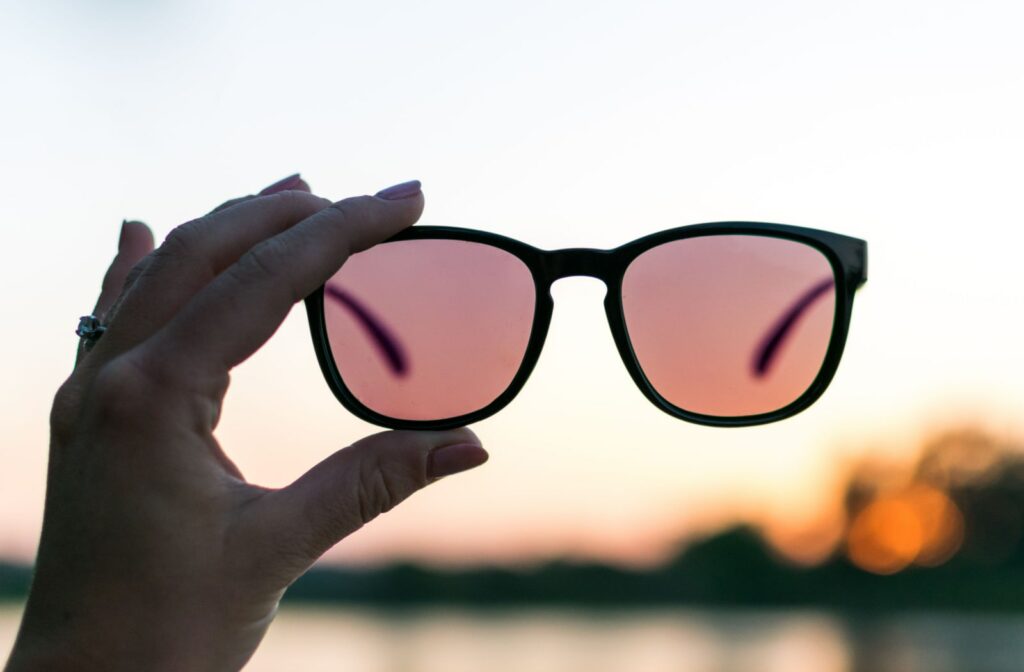When heading out into the bright sun, you probably reach for sunglasses to protect your eyes. But not all sunglasses are created equal.
Polarized sunglasses protect your eyes from harmful ultraviolet rays that can increase your risk of eye disease, but they’re also designed to reduce glare and enhance vision by blocking specific light rays.
But how do they work? And why do some people say they’re a must-have accessory for anyone tackling the great outdoors?
What Are Polarized Sunglasses?
Regular sunglasses filter environmental light and reduce the amount of light entering the eyes. Imagine it like turning down the sun’s brightness.
However, they don’t block intense reflected light or glare off shiny surfaces. Reflected light and glare can cause discomfort and reduce visual clarity, even when wearing sunglasses. But polarized sunglasses are specifically designed to block reflected light and glare so they often work well even on gray, overcast days.
Polarized lenses contain a special filter that contains polarizing material that blocks horizontal light waves, creating clearer, sharper, and more comfortable vision, particularly in sunny conditions.
The Science of Polarization
Polarization refers to the process of filtering out certain types of light waves. In the case of polarized sunglasses, this filtering process reduces reflected light, glare, and other unwanted light waves to provide clearer and sharper vision.
This happens because light waves bouncing off water, snow, or other flat surfaces become horizontal. Polarized lenses are made of vertical lines, meaning the horizontal waves that cause glare are blocked while vertical waves can pass through.
The quality of the polarization can vary from model to model, with some providing more effective glare reduction than others. Additionally, some low-quality polarized lenses can distort colors or reduce visual acuity, so it’s important to invest in a quality pair of polarized sunglasses to support your outdoor lifestyle.
The Benefits of Polarized Lenses
One of the main benefits of using polarized sunglasses is glare reduction without reducing the amount of light to your eyes. This is particularly useful when near a surface of water, snow, sand, or any other reflective surface. Without polarized lenses, your eyes work harder to adjust to the glare. By reducing these reflections, you can enjoy better visibility, less eye fatigue, and improved visual comfort.
Polarized sunglasses also help enhance colors and contrast. By eliminating unwanted light waves that make colors harder to distinguish, you can see small details more vividly.
While they seem like a luxury item, polarized sunglasses can help support your safety and comfort in many outdoor activities. By reducing glare, they can help prevent eye fatigue and headaches, making focusing on the task at hand easier. Additionally, since polarized sunglasses can help you see more clearly in bright, harsh sunlight, they can be useful when engaging in precise activities like driving or fishing.
Polarized sunglasses can be excellent for:
- Fishing
- Golfing
- Driving
- Boating
- Snowboarding/skiing
- Water sports
Generally, anyone who loves spending time outdoors but hates annoying glare can benefit from polarized lenses.
Choosing the Right Pair of Polarized Sunglasses
When choosing polarized sunglasses, there are several factors to consider. First, check if the lenses have 100% UV protection to protect your eyes from harmful UV rays. While polarized lenses are great at cutting down glare, not all of them are manufactured to block UV rays. UV exposure increases your risk of cataracts, macular degeneration, and other eye conditions, so always check your sunglasses tag.
Second, lens color can make a difference:
- Dark lenses are best for bright conditions
- Pale blue lenses help reduce digital eye strain from working in front of a computer
- Light yellow or orange lenses reduce glare during nighttime driving without cutting out ambient light
Experts often advise against using polarized lenses in certain situations because it’s more beneficial to have better visibility of glare. Here are a few reasons why:
- It’s easier to spot ice while driving, snowboarding, or skiing without polarized sunglasses.
- Polarized sunglasses can dim headlights or block reflections off reflective tape at night.
- Polarized lenses can turn LCD screens, like those used in phone screens or computers, black.
A Vision of Advanced Eyewear in Vancouver, WA
Polarized sunglasses can be an essential accessory for anyone looking to protect their eyes and enhance their vision in bright sunlight. By filtering out glare and providing a clearer, sharper image, they’re an amazing tool for any outdoor enthusiast looking to explore the world safely.
And with so many great styles, finding the perfect pair of polarized sunglasses has never been easier. So before you head out to the sunshine, head into Precision Eye Care and see our selection of classy polarized sunglasses.
We’re ready to help keep your vision clear. Book an eye exam today, and let’s make sure your prescription is up to date.





